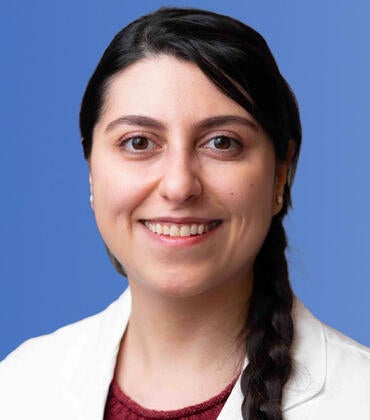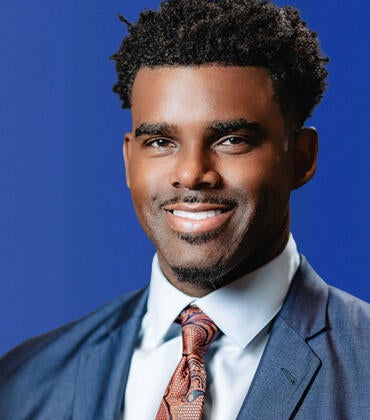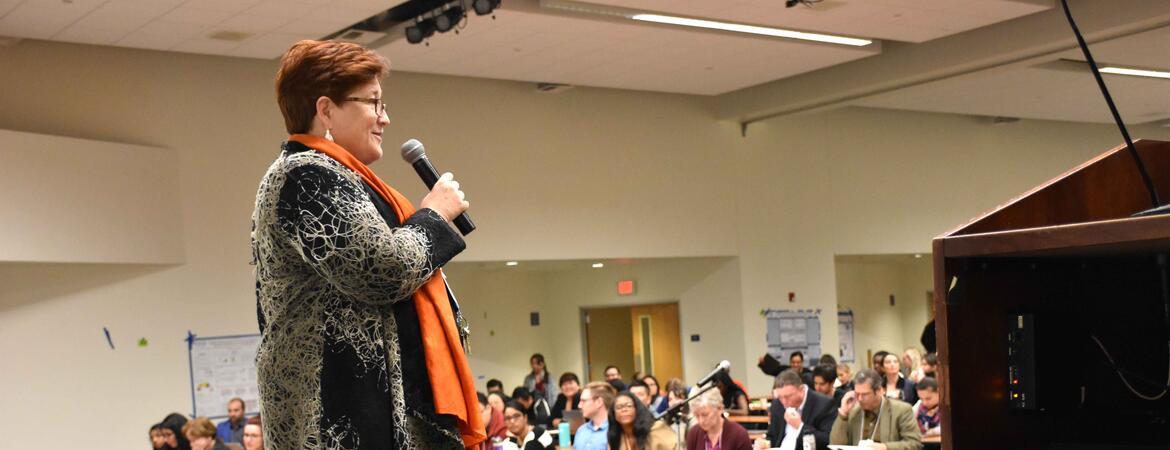
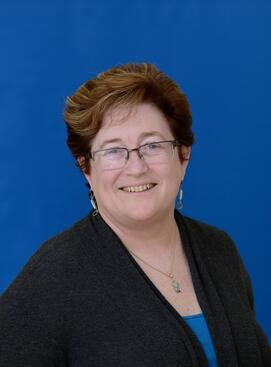
In 2003, Monica J. Carson, PhD, believed she’d work at the Scripps Research Institute in San Diego forever. When friends encouraged her to look at other jobs to be sure she wasn’t missing a better opportunity, she happened upon a job posting at UC Riverside that seemed to describe her own research exactly.
Even then, Carson didn’t expect to move to Riverside. “But when I came to my visit to UCR, I simply fell in love with UCR and the community,” she recalled. “I totally surprised myself that I really wanted to come here.”
Carson, now chair of the Division of Biomedical Sciences and the S. Sue Johnson Presidential Endowed Chair in Glial-Neuronal Interactions, will celebrate 20 years at UCR this year. She was recruited in part to help form the UCR School of Medicine while pursuing her research in immune cells called microglia and their effect on brain health.
“Folks who grow up in the system at UCR don't always appreciate just how wonderful and collegial UCR is, how its mission focus is so important and so rare, and that this is a community that you want to be part of,” Carson said. “It's the community and the mission that drew me here, it's the people that brought me here, and it's all of those things that keep me here.”
Integrating research and mission
For Carson, two words capture her appreciation of UCR as well as her approach to her research and her career as a whole: integration and interaction.
Carson said the UCR SOM, which celebrated its 10th anniversary in 2023, successfully integrates objectives that researchers at other institutions may be forced to choose between. “This is a community that really understands that it's not a choice between doing competitively good research and being mission focused,” Carson explained. “It's really showing that you can combine the best principles of being collegial, focusing on serving the underserved, and having all voices speak, and it's not a choice of doing that versus good science.”
“You're making a real impact this way,” she added. “That's what I love about this–it's both mission and research, teaching and service, all together, integrated.”
Carson also pointed out that the SOM is incorporated into UCR’s main campus as well as the community, rather than being a separate space. “Our strength is being part of the rest of UCR,” she said. “It's by combining across all of our schools, our colleges on campus, that we have this great strength.”
Carson’s research has roots in the idea of integration, too. As a graduate student at the University of Pennsylvania, Carson became interested in brain function and joined a research team focusing on multiple sclerosis. Yet she was perplexed by the common idea at the time that the brain was isolated from the rest of the body and susceptible to damage by the immune system breaching the blood-brain barrier. “That didn't seem to be very good evolutionary selection,” she said. “It got me interested in how the immune system and the brain play well together or don't throughout the lifespan, so pretty much what I've been working on for my career is looking into how the immune system in the periphery and the brain communicate.”
Drawing on community ties
Now, the SOM’s integration with the rest of UCR as well as the surrounding community help inform Carson’s work. Through collaboration with the SOM Center for Health Disparities Research and other centers and colleges at UCR, Carson’s team has benefited from hearing other scholars’ perspectives and participating in community forums. “Our group has had opportunities that perhaps we wouldn't have had to meet certain groups, and to engage with them and to be in the situation to listen to them,” Carson explained, adding that these interactions build on their other community outreach like giving talks at schools and community forums. “These are where we're having these conversations and getting questions, and it's those kinds of questions that shape the way you think.”
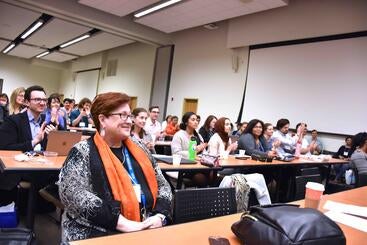
Carson also actively seeks feedback from Inland Empire residents. “When she's doing her research, she's thinking about how that can be interpreted by our local community,” said Emma Wilson, PhD, associate dean for graduate division and a professor of biomedical sciences, adding that Carson is an advocate who frequently reaches out to local stakeholders. She gave an example of Carson and Iryna Ethell, PhD, associate dean of academic affairs, setting up a community forum on autism. “We had parents and children and community leaders listening to aspects of research and panel discussions, and we could hear from them as well, so it was really integrated research with the community,” Wilson said. “Seeing the impact and the interest in the wider communities is very beneficial, and it stops us being such an ivory tower when we're interacting with our local, highly supportive community."
This community input is helpful, Carson explained, because researchers may have a certain idea in mind to investigate, but they’re often coming from a theoretical view or a place of privilege. On the other hand, conversations with community residents and stakeholders can reveal the true questions that need answers. “I’m always trying to get better at hearing what people are trying to tell me,” Carson said.
The memories that most stick in Carson’s mind aren’t necessarily the big events or flashy presentations. “The memorable stories are the quiet conversations with people telling you what the real problems are,” she said.
Conversations with community members influenced Carson’s research toward focusing on factors that people can control. In the past, Carson said, her team investigated genes that were associated with dementia and other diseases. When she spoke to people in the community, though, they commonly expressed feelings of defeat over genetic factors they couldn’t change. Over time, Carson’s team altered their focus to investigating certain exposures, such as to air pollution, that can increase the risk of dementia or other neurodegenerative diseases. “It’s the conversations with our community, of really looking at factors that they can control and that we can control as individuals, that has slowly shifted the questions we're asking,” Carson explained.
Bringing together science and fun
Carson’s theme of interactions also plays a central role in the center she co-founded, so much so that it’s in the name: the Center For Glial-Neuronal Interactions (CGNI).
Carson, Ethell, and Glenn Hatton, PhD launched CGNI in 2007 as the first center in the Division of Biomedical Sciences and, later, the SOM. Carson explained that the center bridges neurology and immunology, allowing researchers to come together to share their individual expertise, integrate ideas, and learn from one another.
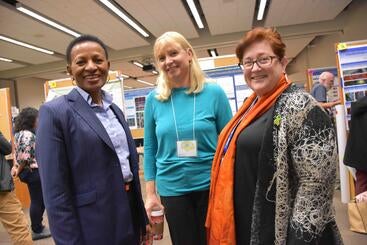
“The center is all about interactions,” Carson said. “Few of us can be experts in everything, but by coming together, we actually can have a much better complete understanding of how the brain functions.”
Every year since its founding, the center has hosted the SoCal Symposium on Glial-Neuronal Interactions in Health and Disease. This year’s 2024 symposium included topics ranging from gut microbiota and the brain axis in Parkinson’s disease, to inflammation and respiration, to the effect of prenatal alcohol exposure on the efficacy of opioids for pain.
Carson said she’s proud to bring speakers from all over the world together at the conference to share their research, but added that much of the conference’s focus is on students. “We really encourage our students while they're in their home base to do what I call high-risk behavior,” she said. “They try out presenting their research and putting it up for criticism, and just having fun and experiencing the joy of presenting science and getting positive feedback.”
She also urges students to practice asking questions, and with Ethell developed conference awards like “best question” to help encourage them. “We find this really allows our students to build confidence and to try out the best way to ask questions and to act as a researcher,” Carson said, adding that the students often enjoy the competition. The presenters select the best questions and students who asked them receive a gift card.
In the end, for Carson, it’s all about these interactions among colleagues, visiting researchers, and students–and, at the same time, having fun. “If a science conference is not fun, it's not a good conference,” she said, explaining that the topics and conversations should be engaging and a little provocative. “And that's what CGNI is all about: We enjoy interacting to talk about research and to collaborate,” she added. “It's just a fun forum for us to get together and is what I call a science party.”
Carson brings this sense of fun to her lab, too. Taher Bhaijee, a biomedical sciences PhD student in her lab, said that Carson organizes quarterly lab lunches and that she and her husband David Lo, MD, PhD, distinguished professor of biomedical sciences, hold an annual ice cream competition. Beyond the enjoyable times in the lab, Bhaijee praised Carson as a mentor. “She is an experimentalist and anything that does not work is just a learning experience for her, which speaks to her resilience,” he said.
Carson works to instill this resilience in her students as well. “I can't promise life is going to be just easy all the time, but you want to be part of a community and you want to be part of these groups that will help you integrate everything, will help support you on all aspects and blend them in a way that is functional and desirable for each individual,” she said. “Let's figure out how you can define your goals, how you can have an integrated life, how you can do experiments in life to find out if something works for you or not. But you can recover from that and try a new experiment.”
The biomedical sciences 50th anniversary and beyond
With the Division of Biomedical Sciences celebrating its 50th anniversary this year, Carson said she looks forward to continuing her work while also taking the time to appreciate the department’s achievements over the decades.
“When we look at this 50-year anniversary, we're looking at the vision of the folks more than 50 years ago about commencing this route that led to this School of Medicine and to this mission of focusing on serving our community,” Carson said. As the original UCR/UCLA Thomas Haider Program in Biomedical Sciences transitioned to a four-year medical school in 2013, she noted that the biomedical sciences graduate program also evolved, developing its current mission to bridge the gaps between traditional researchers and clinicians. “There was a lot of promise,” she said. “And what's been wonderful is to see the promise fulfilled.”
Carson added that she looks forward to seeing the school continue to evolve–and to developing her research alongside it. “I'm glad that this community shapes me and I'm glad to continue growing up with it. And I'm really excited to continue growing old with it,” she said. “But it doesn’t stay static; it's evolving. The community is telling us what it needs, and every step of the way shapes the next step.”

